Continuous Flow Intersection and Upstream Crossover Intersection Comparison
- Research
- Open Access
- Published:
Traffic simulation of continuous flow intersection with displaced left-turn: a case study
Journal of Engineering and Applied Science volume 69, Article number:39 (2022) Cite this article
Abstract
Today, our community is facing a growing numbers of transportation challenges, as traffic grows and congestion worsens for signalized intersections. Based on that its needed balances solutions that improve safety and keep mobility for users with minimum travel time. The objective of this research is to investigate the implementation of continuous flow intersection with displaced left turn with developed simulation traffic model by VISSIM program to evaluate the traffic operation impacts of displaced left turn on performance of signalized intersection in terms of vehicle delay, length of queue, and stopped delay. This research studied congested signalized intersections in Baghdad City. An innovative solution of continuous flow intersection with displaced left turn was implemented to alleviate congestion and high vehicle delay.
The displaced left turn DLT reduced the average vehicle delay about 44% and improved the deterioration level of service from (F) to better level of service (D) for north and south approaches which represented the most congested legs of intersection during the peak period. The results of stopped delay for DLT intersection with developed signal timing were lowest than the conventional intersection by about 51% and 34% for south and north approaches respectively. This implies that DLT intersection reduced the extra stops of vehicle and improved the overall efficiency of signalized intersection. The reduction in the queue length ranged from 47.5 to 42%; otherwise conventional intersection showed long queue length and higher vehicle delay. Therefore, regarding queue length, DLT intersection with developed signal timings strategy had better performance for traffic operation than conventional intersection.
Introduction
Today, our community is facing a growing number of transportation challenges, as traffic grows and congestion worsens for signalized intersections. Based on that its needed balances solutions that improve safety and keep mobility for users with minimum travel time. To achieve these goals, a signalized intersection with displaced left turn are worth considering for more getting vehicle through the same spaces than the conventional intersection. Additionally, displaced left turn allows left turning traffic moves simultaneously with traffic resulting in significant operational benefits: saved time, agency saved cost, and communities benefit from safer facilities. The displaced left turn intersection is known also as continuous flow intersection of CFI moves the left turn crossover upstream and compared to conventional intersection conflicts are fewer at DLT and therefore improving intersection safety.
The objective of this research are to investigate the implementation of continuous flow intersection with displaced left turn with developed simulation traffic model by VISSIM program ver.9 to evaluate the traffic operation impacts of displaced left turn on performance of signalized intersection in terms of vehicle delay, length of queue and stopped delay. The results of simulation models for conventional and displaced left turn (DLT) intersections are compared to investigate the effect of high left turn traffic on their operational performance.
The displaced left turn known as continues flow interstation is also an innovative design to improve mobility and safety by changing the direction of left turn on signalized intersection. This improved efficiency by allowing left turn and through movement on one or multiple approaches to occur at the same time and alleviate congestion. The main advantages of DLT interception is to increase the capacity that eliminate the need for future grade-separation intersections and increase the safety to reduce traffic accidents at high location of traffic vehicle crash (FHWA-HRT-09-060).
The authors [1,2,3,4,5,6] stated the adversely impact of U-turning vehicles on the capacity of a signalized intersections, and their obtained results showed an 8% reduction in the capacity for more than 40% of U-turn vehicles of the overall traffic volume [7].
Abdelrahman et al. [8] studied DLT intersections and concluded that DLT minimized delay at intersections and increased crash frequency in comparison to conventional intersections and recommended for safety countermeasures should be implemented to enhanced traffic safety at displaced left turn intersection (DLT).
Otkovic et al. [9] used the neural network to calibrate the VISSIM simulation model and applied the model on selected case study and gave basic insight to the methods of calibration of VISSIM microsimulation traffic for urban transport network. Otherwise, Qu et al. [10] stated that DLT did not increase the crash rate of overall studied intersections and crash rates that are related to left and right turn were reduced significantly.
Findings from previous studies approved that microsimulation traffic software are useful for implementing and evaluating the operational performance of signalized intersection which will be useful for transportation modeling and accommodating the innovative solution for road network for future traffic volumes. The above studies did not adopt the change in traffic regulation for local regions laws and their effect on performance operation and capacity of signalized intersections.
Case study and data collection
The oversaturated signalized intersections during evening and morning peak hours due to growing number of vehicles within Palestine Arterial Street in Baghdad City and the development of surrounding land uses have become one of the most problems faced currently by road users, as presented in previous researches for same local study area [11, 12].
Al-Sakhara signalized intersection is a four-leg intersection with geometric characteristics presented in Table 1 with left, through and right turn lanes in each direction for all approaches as shown in Fig. 1. Al-Sakhara signalized intersection, which was selected as a case study for this research, suffer poor traffic conditions during peak periods and is incapable of meeting the increasing vehicle demand and induced long queue for left turn vehicles in the south approach that observed from field survey due to high traffic volume in the evening peak periods. Therefore, in order to increase the capacity of Al-Sakhara intersection, improve its level of service, and reduce the long queue, an innovative solution of continuous flow intersection (DLT) is adopted that divert the left turn vehicles to a left turn bay in the middle of block.
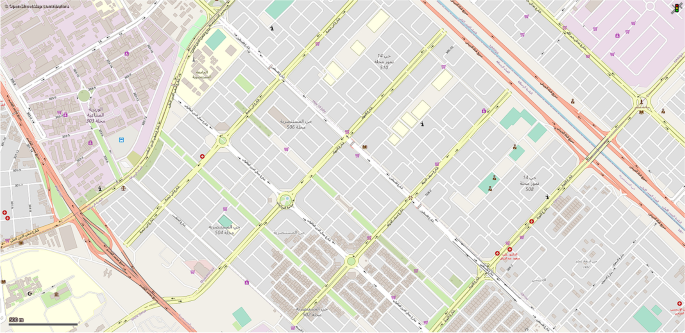
Open street map of Palestine arterial street
Figure 2 shows the Google Map screenshot for the location of the case study. Al-Sakhara intersection with four leg is considered one of most congested intersection along Palestine arterial corridor in Baghdad City.
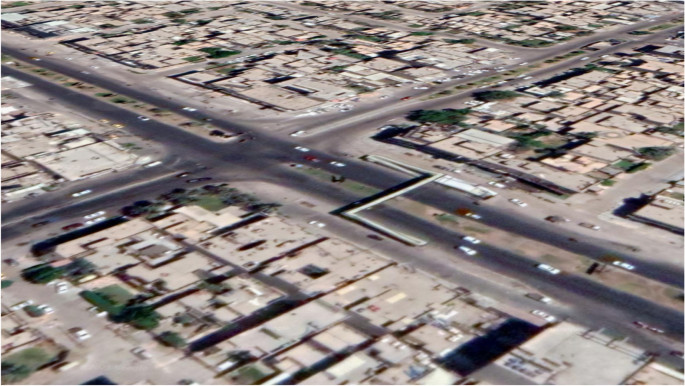
Google Map of Al-Sakhara intersection
The collected field data for traffic volume demand were obtained from manual observation on Tuesday 17 April 2019 and Wednesday 18 April 2019 during sunny weather conditions. The time periods of collecting data for peak evening hours from 6:00 p.m. to 9:00 p.m. because case study explored oversaturated and poor traffic operation conditions due to the its commercial land uses that attract high number of trips and induced high traffic demand. In Iraq follows the right side driving rules and the right turn flow for studied intersection. For Al-Sakhara intersection field survey, the following main points were found:
- 1.
The absence of all- red and amber time phases were observed.
- 2.
The long queue of left turn for the south approach were generated due to high demand volume.
- 3.
High through volume for south and north approaches which splitting to right traffic and caused impedance to their maneuvers that induced high vehicle delay and worse conditions for intersection level of service.
Model calibration
Traffic simulation model is a microscopic, stochastic, and time step behavior model that provides a visual solution for performance of signalized intersection using programming interface [13]. A calibration process was applied to obtain accurate results of simulation model with the observed field data. The aims of calibration process is to find the adjusted parameters for actual traffic state in the field in order to simulate the reliability and accuracy of parameter values used in VISSIM traffic simulation model. To clarify the range of parameters for studied signalized intersection such as the headway distribution within intersection and desired speed distribution. The headway data were estimated by measuring the discharge queue headway for selected intersection (Al-Sakhara intersection) range from 2.1 s to 0.9 s [14]. The desired speed distribution was based on the field data using global positioning system GPS, and accordingly the default speed distribution was modified in VISSIM simulation model by choosing the rectangular distributions from (18 km/h) to (36 km/h) [15].
The methodology for calibration of simulated signalized intersection using VISSIM compare the delay measurement of vehicles obtained from field as measure of performance of fitness parameters for post calibrated model. The comparison was displayed in Fig. 3 and Table 2 with different range for error of percentage from 10.9 to 4.8% for intersection approaches which indicated acceptable convergence for calibrated parameter for simulation model and field data.
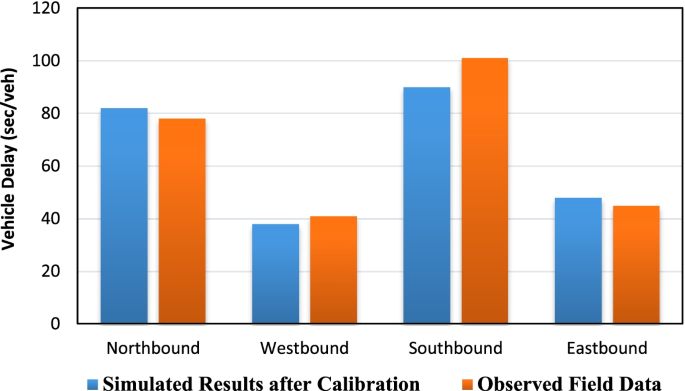
Vehicle delay results for calibration model with field data
Model validation
The microsimulation VISSIM model with adjusted parameters were compared with results obtained from field observation data for validation process to simulate the actual congestion of signalized intersection. The stopped delay results obtained from post calibration VISSIM model were used for comparison with observed field data. The comparison results on which the validation process had been accomplished were presented in Fig. 4 and Table 3. It is obvious from percentage of differences between simulation and field results ranging from 4.7 to 9.1% for all intersection approaches provide acceptable convergence and error below 10% for the validation of simulation model.
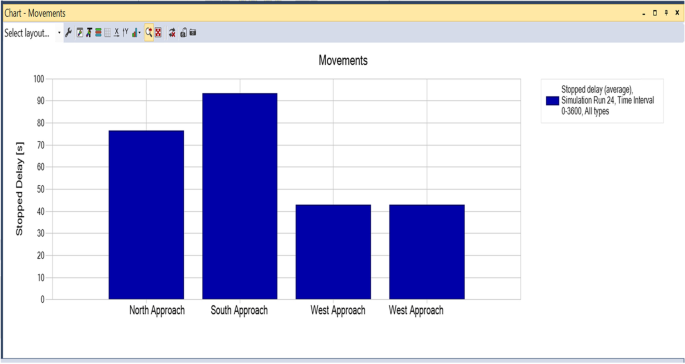
Stopped delay results for VISSIM simulation model
Simulation model of displaced left turn intersection
Microscopic simulation model based on VISSIM ver.9 were developed to evaluate the operational performance of the displaced left turn (DLT) intersection with conventional intersection. Figure 5 depicted the VISSIM simulation model for actual signalized intersection (conventional) without displaced left turn model and Fig. 6 is the VISSIM simulation model for displaced left turn intersection model. To achieve the research objectives, a simulation model-based analysis results interpretation were conducted to study the impact of displaced left turn (DLT) on traffic operation and level of service for signalized intersection.
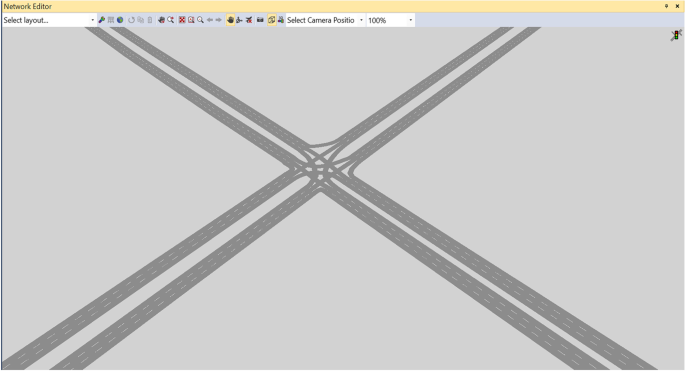
VISSIM simulation model of conventional Al Sakhara intersection
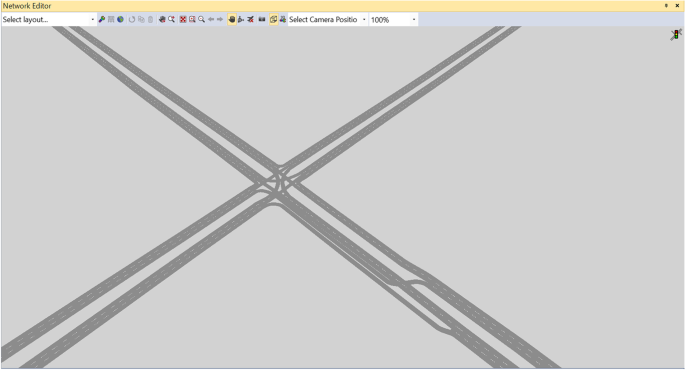
VISSIM simulation model of Al Sakhara intersection with DLT
The traffic indices used for performance evaluation of signalized intersection and for more compressively; vehicle delay, stopped delay, and queue length were estimated. The simulation time was set for 3600 s for each case (conventional intersection and DLT intersection) and multiple test run were applied and the obtained results were averages for the test runs outputs.
Figure 7 shows the simulated results of average vehicle delay for conventional and DLT intersections. It is concluded that DLT intersection induced less vehicle delay as compared with conventional one and for more specific the DLT intersection performed better than conventional intersection in terms of average vehicle delay. The displaced left turn DLT reduced the average vehicle delay about 44% and improved the deterioration level of service from (F) to better level of service (D) as indicated in Table 4 for north and south approaches which represented the most congested legs of intersection during the peak period.
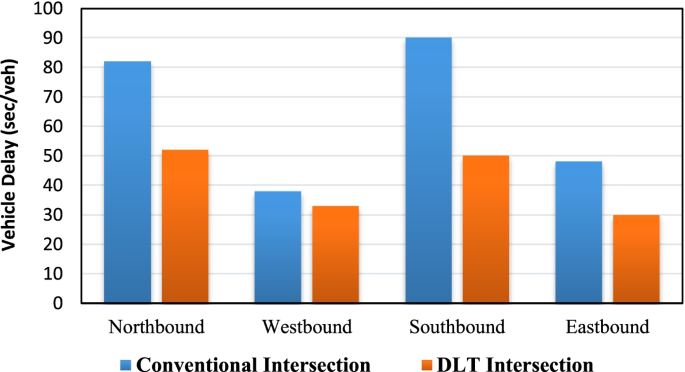
Simulated results for vehicle delay of conventional and DLT intersections
The comparison in this research was done also for stopped delay as one of the considered indices used for evaluating the operation performance of signalized intersections. Figure 8 shows the simulation results for stopped delay and compared the differences between conventional and DLT intersections based on approaches basis. The results of stopped delay according to Fig. 6 and the DLT intersection with developed signal timing presented in Fig. 9 were 45 s and 50 s for south and north approaches which were lowest than the conventional intersection by about 51% and 34% for south and north approaches respectively. This implies that DLT intersection reduced the extra stops of vehicle and improved the overall efficiency of signalized intersection.
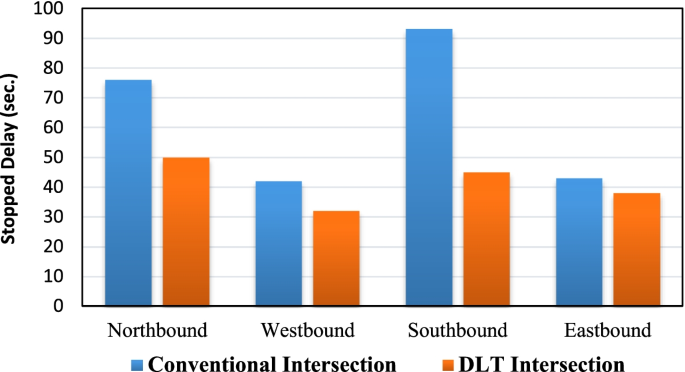
Signal timing phasing for DLT intersection developed by VISSIM
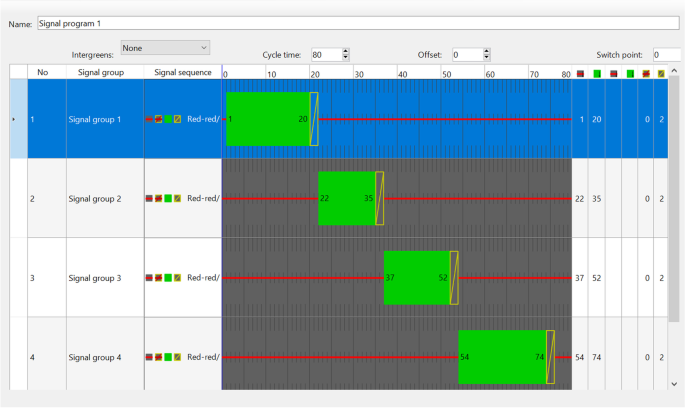
Visual simulation for queue length of conventional intersection
The queue length was also considered in this research as a performance measure of effectiveness for the operational evaluation of DLT intersection. The conventional intersection showed longer queue length for south and north approaches as presented in Fig. 9 which can visually determine the effect of long queue and reflecting the existing conditions for a downstream congestion of south and north approaches for conventional and DLT intersections respectively. The reduction in the queue length ranged from 47.5 to 42% as shown in Fig. 10, and this reduction was due to the displaced left turn for the continuous flow intersection; otherwise, conventional intersection showed long queue length and higher vehicle delay. Therefore, regarding queue length, DLT intersection with developed signal timings strategy had better performance for traffic operation than conventional intersection. Figure 11 shows the visual simulation traffic for DLT intersection.
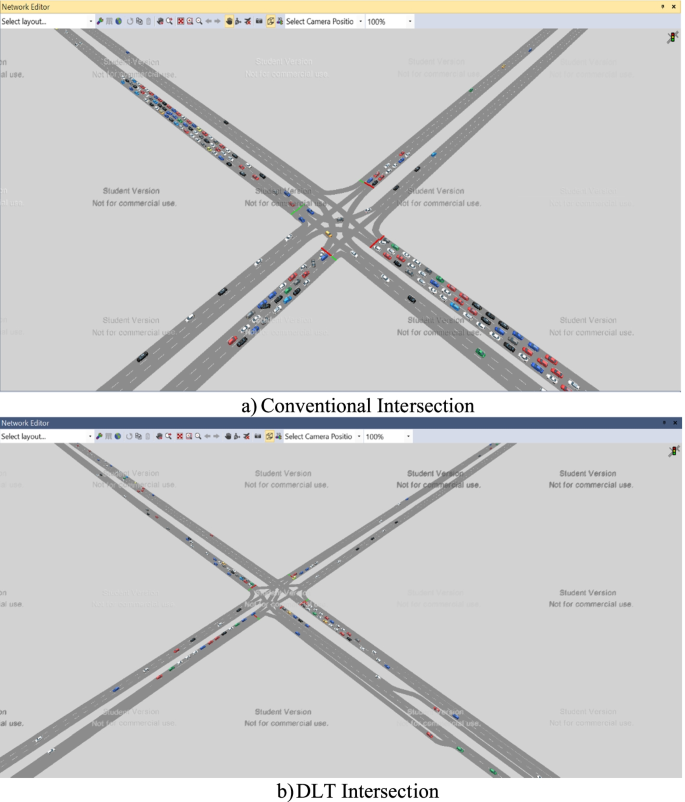
Simulated results for queue length of conventional and DLT intersections
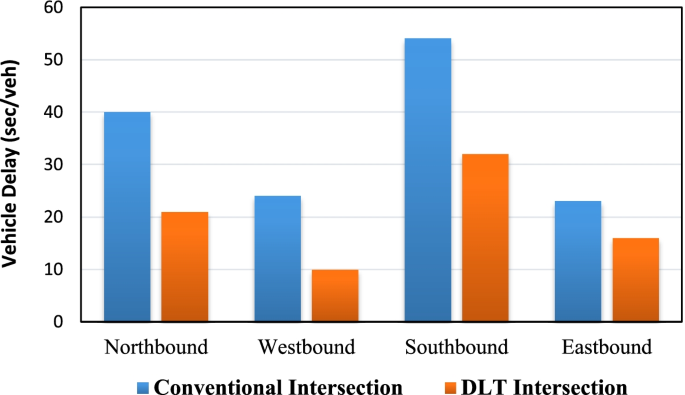
Visual simulated traffic for DLT intersection
Conclusions
This research studied congested signalized intersections in Baghdad City. An innovative solution of continuous flow intersection with displaced left turn was implemented to alleviate congestion and high vehicle delay. A VISSIM simulation software was applied for performance evaluation of Al-Sakhara intersection with displaced left turn. The simulation results showed the following:
- 1.
The displaced left turn DLT reduced the average vehicle delay about 44% and improved the deterioration level of service from (F) to better level of service (D) for north and south approaches which represented the most congested legs of intersection during the peak period.
- 2.
The results of stopped delay for DLT intersection with developed signal timing, were lowest than the conventional intersection by about 51% and 34% for south and north approaches respectively. This implies that DLT intersection reduced the extra stops of vehicle and improved the overall efficiency of signalized intersection.
- 3.
The reduction in the queue length ranged from 47.5 to 42%; otherwise, conventional intersection showed long queue length and higher vehicle delay. Therefore, regarding queue length, DLT intersection with developed signal timings strategy had better performance for traffic operation than conventional intersection.
Recommendation
To find solutions for the traffic congestion problems at signalized intersection, access management strategies such as continuous flow intersections to alleviate congestion intersections should be implemented. Additionally, displaced left turn intersections result in significant operational benefits in saving time and costs.
Availability of data and materials
The data used in this research can be found via the corresponding author.
Abbreviations
- DLT:
-
Displaced left turn
- VISSIM:
-
Verkehr In Städten-Simulations Modell (German for "Traffic in cities - simulation model")
- LOS:
-
Level of service
References
-
Adams JC, Hummer JE (1993) Effects of U-turns on left-turn saturation flow rates. Transp Res Rec 1398:90–100
-
Tsao S-M, Chu S-W (1995) A study on adjustment factors for U-turns in left-turn lanes at signalized intersections. J Adv Transp 29(2):183–192
-
Liu P, Lu J, Fan J, Pernia J, Sokolow G (2005) Effects of U-turns on capacities of signalized intersections. Transp Res Rec 1920(1):74–80
-
Hutchinson P, Woolley JE (2008) Should U-turns be permitted at signalised intersections. Centre for Automotive Safety Research
-
Liu P, Lu J, Zhou H, Sokolow G (2007) Operational effects of U-turns as alternatives to direct left-turns. J Transp Eng 133(5):327–334
-
Zheng C, Liu P, Lu JJ, Chen H (2009) Evaluating the effect effects of U-turns on level of service of signalized intersections using synchro and SimTraffic. Intelligent Vehicle, IEEE Symposium, pp 971–976
-
Inman VW (2008) Evaluation of sign and marking alternatives for displaced left-turn lane intersections, FHWA-HRT-08-071. Federal Highway Administration, Washington, DC
-
Abdelrahman A, Abdel-Aty M, Lee J, Yue L, Al-Omari M'e MA (2020) Evaluation of displaced left-turn intersections. Transp Eng J 1:100006
-
Otkovic I, Alecksandra T, Surdonaj (2020) Validation of the calibration methodology of the micro-simulation traffic model, AIIT 2nd International Congress on Transport Infrastructure and Systems in a changing world, Italy. Transp Res Proc 45:684–691
-
Qu W, Sun Q, Zhao Q, Tao T, Qi Y (2020) Statistical analysis of safety performance of displaced left-turn intersections: case studies in San Marcos, Texas. Int J Environ Res Public Health 17(18):6446
-
Alkaissi ZA (2017) Travel time prediction models and reliability indices for palestine urban road in Baghdad city. Al-Khwarizmi Eng J 13(3):120–130
-
Alkaissi ZA (2018) Analytical study of headway time distribution on congested arterial: a case study palestine road in Baghdad city. In: International congress and exhibition "sustainable civil infrastructures: innovative infrastructure geotechnology", pp 85–97
-
PTV Vision (2009) VISSIM tutorial. PTV AG, Karlruhe
-
Alkaissi Z et al (2020) Discharge headway time distribution model on congested signalized intersections and their operation management: a case study in Baghdad city. IOP Conf Ser Mater Sci Eng 870(1):012091. https://doi.org/10.1088/1757-899X/870/1/012091
-
Alkaissi Z, Hussain RY (2020) Delay time analysis and modelling of signalised intersections using global positioning system (GPS) receivers. IOP Conf Ser Mater Sci Eng 671(1):012110. https://doi.org/10.1088/1757-899X/671/1/012110
Acknowledgements
The author would like to thank Mustansiriyah University (www.uomustansiriyah.edu.iq) in Baghdad, Iraq, for its support of this work.
Funding
No funding was obtained for this study.
Author information
Authors and Affiliations
Contributions
ZAA presented idea of research, developed the theory of traffic simulation computations, verified and calibrated analytical methods, performed analysis, discussed the results and contributed to the final manuscripts. The author read and approved the final manuscript.
Corresponding author
Ethics declarations
Competing interests
The author declares no competing interests.
Additional information
Publisher's Note
Springer Nature remains neutral with regard to jurisdictional claims in published maps and institutional affiliations.
Rights and permissions
Open Access This article is licensed under a Creative Commons Attribution 4.0 International License, which permits use, sharing, adaptation, distribution and reproduction in any medium or format, as long as you give appropriate credit to the original author(s) and the source, provide a link to the Creative Commons licence, and indicate if changes were made. The images or other third party material in this article are included in the article's Creative Commons licence, unless indicated otherwise in a credit line to the material. If material is not included in the article's Creative Commons licence and your intended use is not permitted by statutory regulation or exceeds the permitted use, you will need to obtain permission directly from the copyright holder. To view a copy of this licence, visit http://creativecommons.org/licenses/by/4.0/. The Creative Commons Public Domain Dedication waiver (http://creativecommons.org/publicdomain/zero/1.0/) applies to the data made available in this article, unless otherwise stated in a credit line to the data.
Reprints and Permissions
About this article
Cite this article
Alkaissi, Z.A. Traffic simulation of continuous flow intersection with displaced left-turn: a case study. J. Eng. Appl. Sci. 69, 39 (2022). https://doi.org/10.1186/s44147-022-00091-7
-
Received:
-
Accepted:
-
Published:
-
DOI : https://doi.org/10.1186/s44147-022-00091-7
Keywords
- Traffic simulation
- Continues intersection flow
- Displaced left turn
- VISSIM
- Signalized intersections
- Delay
Source: https://jeas.springeropen.com/articles/10.1186/s44147-022-00091-7
0 Response to "Continuous Flow Intersection and Upstream Crossover Intersection Comparison"
Publicar un comentario